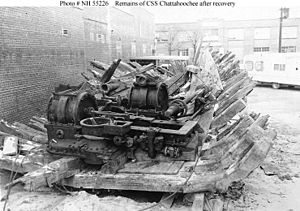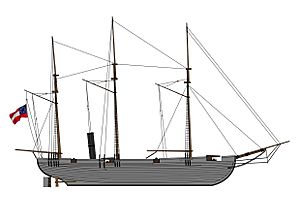CSS Chattahoochee facts for kids
class="infobox " style="float: right; clear: right; width: 315px; border-spacing: 2px; text-align: left; font-size: 90%;"
| colspan="2" style="text-align: center; font-size: 90%; line-height: 1.5em;" | 
Ship's engines and lower portion of the after hull, photographed following recovery in the vicinity of Columbus, Georgia, circa the early or middle 1960s
|}
CSS Chattahoocheewas a Confederate gunboat.
The CSS Chattahoochee was a special kind of ship called a twin-screw steam-powered gunboat. It was built in Saffold, Georgia, and named after the Chattahoochee River where it was constructed. This gunboat joined the Confederate States Navy in February 1863 during the American Civil War.
Contents
| History | |
|---|---|
| Name | Chattahoochee |
| Laid down | Saffold, Georgia |
| In service | February 1863 |
| Fate | Scuttled 17 April 1865, stern raised and put on display in 1963 |
| General characteristics | |
| Length | 150 ft (46 m) |
| Beam | 25 ft (7.6 m) |
| Draft | 8 ft (2.4 m) |
| Speed | 12 knots (22 km/h; 14 mph) |
| Complement | 120 officers and crew |
| Armament | 4 32-pounder smoothbore cannon, a 32-pounder rifled cannon and a 9-inch smoothbore cannon |
|
CSS Muscogee and Chattahoochee
|
|
| NRHP reference No. | 70000212 |
| Added to NRHP | May 13, 1970 |
Building a Warship: The CSS Chattahoochee
During the American Civil War, the Confederate States Navy wanted to break a "blockade" set up by the United States Navy. A blockade is when ships surround a port to stop other ships from entering or leaving. This blockade was at Apalachicola Bay, stopping trade to places like Columbus, Georgia. The Confederates planned to build strong warships near Columbus. These ships would then sail down the river to challenge the US Navy.
Designing and Building the Gunboat
In October 1861, the Confederate Navy hired David S. Johnston to build a gunboat. It was supposed to be ready in four months. But it took much longer, finally being delivered in December 1862. Even then, it still needed more work. The ship was officially ready for service on February 24, 1863, and was named the CSS Chattahoochee.
The Chattahoochee was a large ship. It was about 130 feet (40 m) (39.6 m) long and 30 feet (9.1 m) (9.1 m) wide. It needed 8 feet (2.4 m) (2.4 m) of water to float. It had three masts for sails and two steam engines. Using both sails and engines, it could travel up to 12 knots (22 km/h; 14 mph) (22 km/h).
Who Commanded the Chattahoochee?
Lieutenant Catesby ap Roger Jones was put in charge of the Chattahoochee in July 1862. He was a very experienced officer. He had helped turn the captured USS Merrimack into the famous iron-clad ship, the CSS Virginia. He even commanded the Virginia in a big battle against the USS Monitor.
When Jones arrived in Saffold, he worked hard to finish the Chattahoochee. He found it tough to get supplies for the ship. By September, he had his officers, but no crew members yet.
River Obstacles and Defenses
While the Chattahoochee was being built, the Confederate Army left the city of Apalachicola. This meant Union forces could easily attack the rivers nearby. The governors of Alabama, Florida, and Georgia asked the Army to protect these areas. They wanted obstacles in the Apalachicola River and gun batteries along its banks.
By the time the Chattahoochee was ready, the river was blocked. A large chain connected to sunken rafts was stretched across the river at a place called the "Narrows." This was about 36 miles (58 km) (58 km) above Apalachicola. The chain caught logs and other debris, making it impossible for ships to pass. Gun batteries were also placed at Ricco's Bluff and Alum Bluff. These defenses were meant to stop Union ships from coming up the river.
Life on the River: Early 1863 Challenges
The Chattahoochee spent the first part of 1863 getting ready. The crew trained, and the ship underwent repairs. There were constant problems with its engines. On January 30, it even hit a rock, causing a big leak. Because of these issues and the river blockades, the ship could not go to the Gulf of Mexico. It couldn't complete its main mission of fighting the US Navy ships. The Chattahoochee never even reached the "Narrows" obstacle. It could have helped defend it, but it stayed further upriver. Even though it was far from battles, the ship lost crew members due to illness and desertion. In late January 1863, Lt. Jones was moved to Texas. Lt. John Julius Guthrie took over command in late February.
A Trip Downriver and a Shallow Spot
In early April 1863, the Chattahoochee sailed down the river to check on the gun batteries. It then stayed at the town of Chattahoochee, Florida. This is where the Chattahoochee River meets the Flint River to form the Apalachicola River.
In late May, the U.S. Navy found out that a ship called the Fashion was loading cotton north of Apalachicola. The Fashion was a "blockade runner," meaning it tried to sneak past the blockade. Lieutenant Commander George H. Morris sent three boats from his ship, the USS Port Royal. They captured the Fashion.
Lt. Guthrie heard about this and sailed the Chattahoochee downriver to help. But the Chattahoochee got stuck on a sandbar near Blountstown. The water was only 7.5 feet (2.3 m) (2.3 m) deep, but the ship needed 8 feet (2.4 m) (2.4 m) of water. While waiting for the river to rise, Guthrie learned that the Fashion had already been captured. So, he decided to return to Chattahoochee the next day, May 27.
A Terrible Accident and the Ship's End
On May 27, 1863, a terrible accident happened. The crew started heating the ship's boiler, but they didn't pump water into it for almost two hours. Around noon, the boiler exploded. This explosion was a disaster. Nineteen people on board the Chattahoochee were killed or died later from their injuries. Some even drowned trying to swim to shore.
Word of the explosion was sent upriver, and another ship arrived that night. The dead and wounded were moved to the river banks. But they were left outside, exposed to the weather. All day on May 27, a hurricane had been moving towards the Apalachicola River valley. The hurricane, a Category 2 storm, hit the area around sunrise on May 28. The injured people lay on the shore for over 24 hours, unprotected from the strong winds and heavy rain. After the hurricane passed, the bodies and wounded were taken back to Chattahoochee. The injured didn't get proper medical care until five days after the explosion. About 40 hours after the explosion, a slow leak finally caused the Chattahoochee to sink.
Attempts to Repair and Final Days
David Johnston, who had built the Chattahoochee, managed to raise the sunken ship. But he left it at his boatyard, and much of its equipment was taken off. Repairs finally began in December 1863 at the Columbus Navy Yard.
Lt. George Washington Gift was put in command of the Chattahoochee in March 1864. He had served on the ship before. In late April, Gift tried to take the repaired Chattahoochee on a mission against US Navy ships near Apalachicola. But the ship ran aground, meaning it got stuck in shallow water. Gift then moved to a civilian steamer. In early June, Gift was ordered to take the Chattahoochee back to the Columbus Navy Yard. He and his crew were sent to Savannah, Georgia to serve on another ship, the CSS Waterwitch. The Chattahoochee's repairs were never finished, and it did not return to service before the war ended.
In December 1864, the Confederates left the Apalachicola River. The Chattahoochee was moved up the Chattahoochee River. On April 17, 1865, as Union troops got close to Columbus, the ship was intentionally sunk (called scuttled) to prevent it from being captured.
What Happened to the Chattahoochee?
The Chattahoochee stayed underwater until 1963. Its remains were found near Fort Benning. Later, parts of the ship, including a section of its hull and its original steam engines, were brought up. They were returned to Columbus and are now on display at the National Civil War Naval Museum. Because it was sunk and stayed underwater for 100 years, the Chattahoochee is the only Confederate Navy gunboat that survived into modern times.
Images for kids
- This article incorporates text from the public domain Dictionary of American Naval Fighting Ships.
- "An Investigation of the Remains of the Confederate Gunboat CSS Chattahoochee, East Carolina University's Program in Maritime History and Underwater Research




